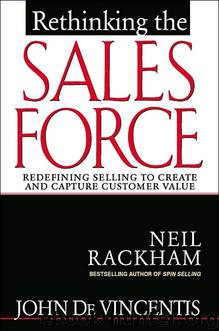Rethinking the Sales Force: Redefining Selling to Create and Capture Customer Value by John Devincentis & Rackham & Neil Rackham

Author:John Devincentis & Rackham & Neil Rackham
Language: eng
Format: azw3, epub
Tags: Self-Help.Business & Career
ISBN: 9780071342537
Publisher: McGraw-Hill
Published: 1999-04-01T10:00:00+00:00
The shift from reporting tools to planning tools
The shift from product communication tools to value identification tools
FROM REPORTING TOOLS TO PLANNING TOOLS
The reporting tools of most sales organizations add no value to customers. On the contrary, they are a source of negative value by taking up time that could otherwise be used by the salesperson to create customer value. Most organizations have reporting requirements that take salespeople a minimum of two or three hours per week to complete. With sales forecasts, call reports, expense and activity reports, not to mention all the other internal demands for information, salespeople often feel that the customer comes a distant second in terms of institutional priorities. Companies generally view their reporting demands as a necessary evil and excuse them saying that, on the whole, they are carried out after business hours and on the salesperson’s own time. Nevertheless, the fact remains that the majority of reports are exclusively for the benefit of the selling institution, and neither salespeople nor their customers benefit from them.
Activity tracking may have a role in transactional selling, but in consultative selling, it can be downright counterproductive. In Rackham and Ruff, Managing Major Sales (Harper & Row, 1991), we describe a number of cases where the introduction of activity management systems in consultative sales forces actually led to a significant fall in sales results and in customer satisfaction. So it’s refreshing to see a number of major organizations such as IBM, Microsoft, Procter & Gamble, and Johnson & Johnson shift the emphasis of parts of their reporting systems so that they have a more positive impact in terms of creating institutional value. The shift, put simply, is from an emphasis on reporting after the event to planning before it happens. A call report completed after a customer visit adds very little value. The call is over; it’s history, and reporting on what happened won’t change a thing. The same effort, however, put into call planning before the customer visit can result in a more purposeful and organized meeting that adds customer value. Call planning has the potential to change history rather than to catalog it. By providing better call-planning tools, especially if call plans are coupled with systematic coaching, the institution can create value that, in the execution of the plan, becomes visible to customers.
Download
Rethinking the Sales Force: Redefining Selling to Create and Capture Customer Value by John Devincentis & Rackham & Neil Rackham.epub
This site does not store any files on its server. We only index and link to content provided by other sites. Please contact the content providers to delete copyright contents if any and email us, we'll remove relevant links or contents immediately.
| Advertising | Consumer Behavior |
| Customer Service | Marketing |
| Public Relations | Sales & Selling |
| Search Engine Optimization |
Influence: The Psychology of Persuasion by Robert B. Cialdini(4715)
The Miracle Morning by Hal Elrod(4636)
The Hacking of the American Mind by Robert H. Lustig(4318)
Pre-Suasion: A Revolutionary Way to Influence and Persuade by Robert Cialdini(4142)
Unlabel: Selling You Without Selling Out by Marc Ecko(3587)
Ogilvy on Advertising by David Ogilvy(3503)
Hidden Persuasion: 33 psychological influence techniques in advertising by Marc Andrews & Matthijs van Leeuwen & Rick van Baaren(3472)
Purple Cow by Seth Godin(3137)
Who Can You Trust? by Rachel Botsman(3086)
Kick Ass in College: Highest Rated "How to Study in College" Book | 77 Ninja Study Skills Tips and Career Strategies | Motivational for College Students: A Guerrilla Guide to College Success by Fox Gunnar(3070)
The Marketing Plan Handbook: Develop Big-Picture Marketing Plans for Pennies on the Dollar by Robert W. Bly(2975)
This Is Marketing by Seth Godin(2969)
I Live in the Future & Here's How It Works by Nick Bilton(2933)
The Power of Broke by Daymond John(2893)
Building a StoryBrand by Donald Miller(2838)
The Tipping Point by Malcolm Gladwell(2820)
The 46 Rules of Genius: An Innovator's Guide to Creativity (Voices That Matter) by Marty Neumeier(2796)
Draw to Win: A Crash Course on How to Lead, Sell, and Innovate With Your Visual Mind by Dan Roam(2732)
Market Wizards by Jack D. Schwager(2643)
